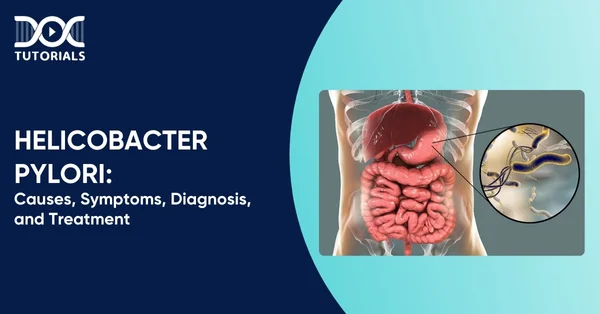Helicobacter Pylori | Causes, Symptoms, Diagnosis, and Treatment

Helicobacter pylori (H. pylori) is a spiral-shaped bacterium that infects the stomach lining and the duodenum, the initial portion of the small intestine. Although many individuals carry the bacterium without experiencing any symptoms, it can cause significant gastrointestinal conditions like gastritis and peptic ulcers due to persistent inflammation.
If not treated, infection may raise gastric cancer risk potentially. Understanding the Helicobacter pylori causes, symptoms, diagnosis, and management is crucial for the NEET PG candidates. Both aspiring doctors and current practising physicians need a good understanding of this subject to strengthen their clinical capabilities.
Continue reading for a detailed look at Helicobacter pylori infection.
What is a Helicobacter Pylori Infection?
H. pylori is an acidophilic bacterium that infects the stomach. It is the most prevalent chronic bacterial infection in humans and infects more than half of humans on Earth. Notably, the majority of individuals with H. pylori infection are healthy.
The disease usually affects children and is more frequent in developing nations. The risk of infection is increased in populations that have higher crowding and poor sanitation.
What are the Causes of Helicobacter Pylori?
The exact mechanism of H. pylori spread is not known. However, the bacterium has been found to have remained with humans for thousands of years. Scientists feel that the infection can be spread through several mechanisms, such as:
- Oral-to-Oral Transmission: Kissing, sharing utensils, or close contact can spread bacteria through saliva.
- Faecal-to-Oral Transmission: Not washing hands properly after using the restroom can spread bacteria through contaminated hands or surfaces.
- Eating Contaminated Food or Water: In unsanitary conditions, eating or drinking food or water that has come into contact with faeces can result in infection.
What are the Symptoms of Helicobacter Pylori?
For the majority of the time, H. pylori infection shows no signs or symptoms. Research indicates that approximately 30% of individuals infected with the bacteria will experience complications such as gastritis or peptic ulcers. This is because the bacteria cause damage to the lining of the stomach.
Symptoms of H. pylori peptic ulcers may consist of:
- Stomach dullness or burning pain
- Fullness following a light meal
- Bloating in the abdomen
- Nausea
- Unintentional weight loss
- Vomiting
- Excessive burping
Although unusual, persistent infection with H. pylori has been linked to an increased risk of gastric cancer due to chronic inflammation. Symptoms that are suggestive of stomach cancer include:
- Acid reflux or heartburn
- Chronic indigestion
- Difficulty swallowing
- Decreased appetite
- Unintentional weight loss
- Abdominal swelling or pain
- Enduring fatigue
It’s essential to remember that these symptoms can also be associated with other digestive conditions.
What is the Diagnosis of Helicobacter Pylori?
A physician will likely question the patient regarding medical history, family history, medicines the patient currently takes, and symptoms experienced in the initial portion of the diagnostic process. A physical examination is also conducted, usually a light pressing over the abdomen to check for tenderness or bloating.
H. pylori diagnosis involves:
- Stool Tests
- Stool Antigen Test: A test that searches for the presence of H. pylori chemicals in the stool and is often employed to identify active infection.
- Stool PCR (polymerase chain reaction) Test: A test that detects bacterial DNA (deoxyribonucleic acid) as well as mutations that may result in resistance to antibiotics. While helpful, it is more expensive and less accessible.
- Urea Breath Test
In this non-invasive examination, the patient will be required to blow into a bag to get baseline carbon dioxide measurements. They will be requested to drink a liquid or a pudding with urea. If they have H. pylori in the gut, it will digest the urea and release carbon dioxide, which is then captured from a subsequent breath sample.
The samples are processed in the lab to verify the infection. Further testing to investigate ulcers or rule out complications may include:
- Upper Gastrointestinal Endoscopy: A flexible tube with a camera passed down through the mouth to visualise the oesophagus, stomach, and duodenum. Tissue samples may be obtained for biopsy during the procedure.
- Upper Gastrointestinal (GI) Series (Swallowing Barium): Barium-containing liquid is swallowed prior to taking X-rays. This assists in outlining stomach or intestinal abnormalities.
- CT (computed tomography) Scan: A more advanced imaging procedure which is useful in diagnosing changes in the structure, e.g., ulcers or tumours, of the stomach.
What is the Treatment for Helicobacter Pylori?
Treatment for H. pylori is usually combination therapy in the form of a combination of at least two antibiotics. Two-spectra attack ensures antibiotic resistance is not formed. In addition to the antibiotics, acid-reducing medications are given to permit recovery of the stomach lining.
Common drugs used are:
- Proton Pump Inhibitors (PPIs): These medications reduce how much acid the stomach secretes. Examples include omeprazole (Prilosec), esomeprazole (Nexium), lansoprazole (Prevacid), and pantoprazole (Protonix).
- Bismuth Subsalicylate: This shielding GI medication covers the lining and insulates it against acid burn.
- Histamine H2-Receptor Blockers: These medications decrease acid by inhibiting signals to histamine in the stomach. Cimetidine (Tagamet HB) is commonly used as an example, although H2 blockers are generally reserved if PPIs are not possible to take.
Aftercare is typically advised at least four weeks after treatment completion to confirm infection was eliminated. If the test remains positive, the doctor may prescribe a new set of antibiotics to eradicate the bacteria.
FAQs About Helicobacter Pylori
- How long can someone have H. pylori without knowing?
Most people harbour the bacteria for years without having symptoms. In such cases, inflammation of the stomach lining may be present without any noticeable signs.
- Does H. pylori need to be treated with antibiotics?
Yes, two antibiotics taken twice daily for a week are usually necessary to eradicate the infection completely and decrease the likelihood of resistance in most cases.
- What are the H. pylori complications?
If not treated, H. pylori infection can cause peptic ulcers and, in advanced cases, gastric cancer due to long-term inflammation of the stomach lining.
- Is there a vaccine for H. pylori?
No vaccine for H. pylori is currently available. Although a couple of potential candidates have reached early-stage clinical trials, drug companies have not prioritised vaccine development for this infection.
- What is the fastest way to cure H. pylori?
The best option is a 7-14-day regimen of at least two antibiotics combined with acid-reducing agents like PPIs. The procedure concludes the treatment in a comprehensive way and reduces the risk of recurrence to a minimum.
Conclusion
Although H. pylori infection might be worrisome, it is common and often goes unnoticed. When symptoms do develop, they are manageable with appropriate treatment. Most patients respond well to a short course of antibiotics and acid-reducing medications, leading to full recovery.
For NEET PG aspirants, learning about H. pylori establishes a sound clinical base that will contribute to success in exams as well as the real practice of medicine. Familiarity with the most recent diagnostic techniques and evidence-based treatment makes you stand out in the prevailing competitive environment.
DocTutorials offers a structured and high-impact learning process with high-yield video lessons, swift revision modules, and structured notes intended to help you succeed. Join DocTutorials’ NEET PG course today and excel in your medical career!
Latest Blogs
-

NEET SS Exam 2024: Analysis, Key Dates, Counselling
The NEET SS 2024 exam kicked off on March 29, 2025. Over two days and two slots, candidates across 13…
-

NEET PG Registration 2025: An Essential Guide For Exam Prep
The NEET PG registration, which is conducted online, is a crucial step in the exam process. Filling out the NEET…
-

NEET PG Syllabus 2026: A Must-Have Complete Guide for Exam Success
The NEET PG Syllabus acts as one of the foundation stones for aspiring postgraduate medical students like you who are…




